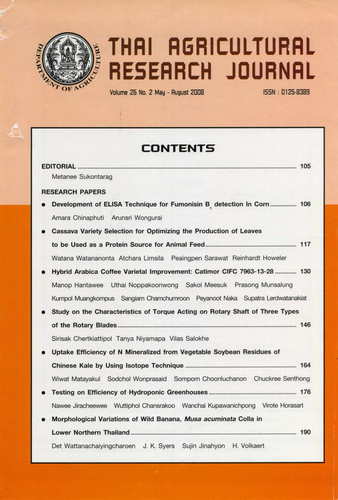Cassava Variety Selection for Otimizing the Production of Leaves to be Used as a Protein Source for Animal Feed
DOI:
https://doi.org/10.14456/thaidoa-agres.2008.11Keywords:
cassava variety, dry leaf yield, proteinAbstract
The unlignified upper part of the cassava plant is potentially a good source of protein as nutritive value for animal feed rations and high yield. There are many recommended varieties for root high only but not for upper part for feeding. Comparison among varieties should be ideal need for animal feeding. Cassava variety selection trials was established for optimizing the production of leaves and wee then conducted to select cassava variety with high dry yield leaf and protein content at Rayong Field Crops Research Centre (FCRC), Khon Kaen FCRC and Songhla FCRC during 2002-2006. The variety trial consisted of 24-25 cassava varieties as treatments except at Song Kla FCRC obly 14 varieties arranged in RCB with 4 replications. The results at Rayong FCRC indicated that thee were varieties differences in Total dry leaf yield (sum of 5 cuts) which varied from 1.48-2.74 t/rai as well as protein content from 15.87-18.99%. In another two-year trial conducted from 2004-2006; CMR 43-78-2 gave the highest dry leaf yield of 4.56 t/rai and a protein yield of 725 kg/rai from a total of 10 cuts. The total dry leaf yield (sum of 4 cuts) of Khon Kaen FCRC varied from 1.27-2.08 t/rai with protein content from 17.73-21.52%. Songhla FCRC gave 3.50-6.37 t/rai for the total dry leaf yield (sum of 7 cuts) and also the protein content from 13.62-18.68%. Nine cassava varieties were selected for further studies on farmers; fleds tria. So that it is possible to select cassava varieties for both high yield of leaf as well as protein content.
Downloads
Published
How to Cite
Issue
Section
License
Copyright (c) 2017 วารสารวิชาการเกษตร (Thai Agricultural Research Journal)

This work is licensed under a Creative Commons Attribution-NonCommercial-NoDerivatives 4.0 International License.
Thai Agricultural Research Journal



